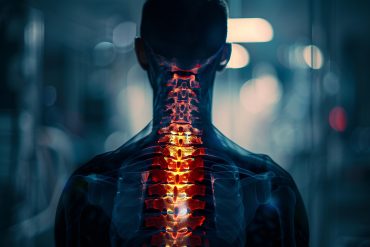Summary: A new study reveals a person’s pupil dilation may give hints as to their risk of developing depression following a natural disaster.
Source: Binghamton University.
Pupil dilation could identify which individuals are at greatest risk for depression following disaster-related stress, and help lead to targeted interventions, according to new research from Binghamton University, State University of New York.
Researchers at Binghamton University recruited 51 women who were living in the greater Binghamton, N.Y., area at the time of a catastrophic 2011 flood and who reported a life event indicating that they or their child had been impacted by the flood to some extent. To participate in the study, women were either required to have a lifetime history of major depressive disorder or no lifetime diagnosis of any DSM-IV mood disorders. The researchers’ findings indicated that decreased pupil dilation to emotional facial expressions predicted a significant increase in post-flood depressive symptoms, but only among women who experienced higher levels of flood-related stress.
“One of the theories of depression is that there’s a lot of vulnerabilities for depression that lay latent until stress activates them,” said Mary Woody, Binghamton graduate student and lead author of the study. “Our idea with the flood is. Here’s this big objective experiment where there’s a disaster outside of everyone’s control, and it’s happening to the community and there’s kind of varying levels of stress that are happening at each of these family dyads. Our idea was to look at a vulnerability factor/risk factor pupil response and see if we could predict which families have the most depression following the flood if they had more of this particular risk factor.”
The findings suggest that interventions designed to target deficits in cognitive-affective responding may be effective for prevention and intervention programs for depression following natural disasters.
“In light of the current findings, it is certainly plausible that individuals displaying decreased pupillary response to emotional stimuli and relatively higher levels of disaster-related stress may be good candidates for cognitive therapy to alleviate their depression,” said Brandon Gibb, professor of psychology at Binghamton University, director of the Mood Disorders Institute and Center for Affective Science, and co-author of the study.

The study is the first to examine how pupillary response to emotional stimuli may interact with life stress to predict prospective depression. If replicated and extended, the current findings may further our understanding of how cognitive-affective response plays a role in stress and depression and also aid clinicians in identifying those most at risk following a natural disaster, wrote the researchers.
“After natural disasters only about 20-25 percent of people are going to go on to develop depression. Because there’s limited resources following a natural disaster, it will be way too expensive for us to be able to give them the psychiatric care,” said Woody. “One of the implications in this project is to be able to identify whom might be at greatest risk for depression following a natural disaster, so we may be able to design some sort of intervention that targets those individuals, and it is more cost effective in that way.”
Source: Mary Woody – Binghamton University
Image Source: NeuroscienceNews.com image is credited to the National Weather Service.
Original Research: The paper, “Pupillary response to emotional stimuli as a risk factor for depressive symptoms following a natural disaster: The 2011 Binghamton flood,” will be published in Clinical Psychological Science.
[cbtabs][cbtab title=”MLA”]Binghamton University “Depression Risk Following Natural Disaster Can Be Predicted By Pupil Dilation.” NeuroscienceNews. NeuroscienceNews, 23 May 2017.
<https://neurosciencenews.com/pupil-dilation-depression-6757/>.[/cbtab][cbtab title=”APA”]Binghamton University (2017, May 23). Depression Risk Following Natural Disaster Can Be Predicted By Pupil Dilation. NeuroscienceNew. Retrieved May 23, 2017 from https://neurosciencenews.com/pupil-dilation-depression-6757/[/cbtab][cbtab title=”Chicago”]Binghamton University “Depression Risk Following Natural Disaster Can Be Predicted By Pupil Dilation.” https://neurosciencenews.com/pupil-dilation-depression-6757/ (accessed May 23, 2017).[/cbtab][/cbtabs]
Abstract
Cultural Differences in Visual Search for Geometric Figures
While some studies suggest cultural differences in visual processing, others do not, possibly because the complexity of their tasks draws upon high-level factors that could obscure such effects. To control for this, we examined cultural differences in visual search for geometric figures, a relatively simple task for which the underlying mechanisms are reasonably well known. We replicated earlier results showing that North Americans had a reliable search asymmetry for line length: Search for long among short lines was faster than vice versa. In contrast, Japanese participants showed no asymmetry. This difference did not appear to be affected by stimulus density. Other kinds of stimuli resulted in other patterns of asymmetry differences, suggesting that these are not due to factors such as analytic/holistic processing but are based instead on the target-detection process. In particular, our results indicate that at least some cultural differences reflect different ways of processing early-level features, possibly in response to environmental factors.
“Cultural Differences in Visual Search for Geometric Figures” by Yoshiyuki Ueda, Lei Chen, Jonathon Kopecky, Emily S. Cramer, Ronald A. Rensink, David E. Meyer, Shinobu Kitayama, and Jun Saiki in Cognitive Science. Published online March 25 2017 doi:10.1111/cogs.12490






